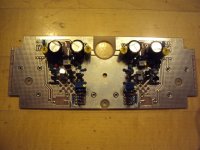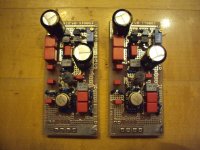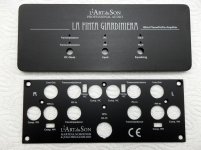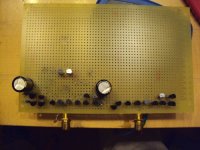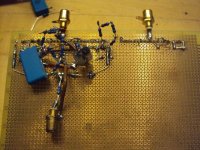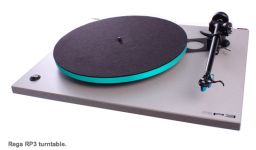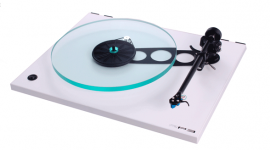No, the MC input is a parallel symmetric Fet design with folded cascodes and current mirrors. One option is using the gates ( transconductance ), the other using the sources ( transimpedance ).The inputs are not differential for minimum noise. Input offset, distortion and output offset can be trimmed, so there is no servo.This stage has no global feedback. It is the PCB that shimmers in silver. The second stage ( the small PCB´s up and down ) uses an Opamp for active RIAA based on Selfs Precision RIAA but DC coupled and with another trick to put the DC blocking Elcap to ground in a feedback loop. This is also the MM input. The output stage is my N-channel cascode buffer that has also a DC offset trim so you could say that the whole schebang is DC coupled without servo with the exception of the DC blocking Elcap to ground in the MM stage. There is a switchable subsonic filter between the Opamp and the buffer. Taking out the pole correction in the RIAA you end up approximately with the infamous Neumann curve. This stage has a lot of options but nevertheless can be used easily ones it is adjusted.
They work technically different and they sound different. The transconductance is very fluid and nice and the transimpedance majors on raw dynamics and slam when the cartridge fits, e.g. is of rather low impedance. In praxis even a 40 Ohm Denon DL103 works well. There is another advantage : the input capacitance of J-Fets is somewhat un-linear and using the sources as input avoids that. It also has more speed theoretically because of less Miller effect. This is mostly known from BJT´s but happens in Fets too, even in tubes. When Miller described the effect transistors had not even being invented. On the other hand the folded cascodes suppresses both effects well so i do not make a big deal out of it. The sound difference may come from other effects, namely because the TI takes the current of the MC so the amount of information that flows into the sources is higher. There also may be an eddy break effect at work damping the movement of the needle in the grove somewhat like damping factor of a power amp. The 10 Ohm i use is not that effective in both senses say with my 5.5 Ohm Titan i so this is a bit philosophic. You could even talk about a power transfer input that some people think is optimal. That would be the case when the MC cartridge had 10 Ohm impedance itself. The disadvantage is that the input impedance is fixed ( in this case around 10 Ohm ) and not adjustable. Most people want that, so i included the transconductance input. There is another problem with TI. Most magazines can not measure it due to the low input impedance that gives the Audio Precision a hard time.. Show me a test report with noise and RIAA measurements on a transimpedance input. I can do it so i am a bit speechless why others have that problem.
See some closeups of the PCB´s. The relays and DIP switches have not being fitted yet.
See some closeups of the PCB´s. The relays and DIP switches have not being fitted yet.
Attachments
I promised a bipolar version of the Naked Truth phonostage. Hear it is. The input stage is from my Nobrainer. You can see another mirror on top of the current mirror with cascode. That is to make the output impedance as high as possible. OK, this is not that simple any more but should avoid some problems. Also you see a DC servo. That has to be tested out.
Attachments
As i already reported i have build one side of the Starless. Tonight i build the other side so until tomorrow i will have it working if the old one does me that favour. I made some small changes to the schematic that MiiB posted. I do not use the 47kOhm differential feedback resistors ( i will try that later). I decided on an AC coupled version and i am using a 1MOhm resistor from buffer input to ground. Curiously the buffer worked AC coupled without that resistor so the leakage in the cap was enough to ignite the Fet. I just do not trust this arrangement. I raised the coupling cap to 100nF. It is a good quality RIFA PP and i think it does no damage to the sound. I experimented a lot with various servos. That is one of the reasons that this project is a bit delayed. Ultimately i decided against it in the sake of simplicity. I also lowered the gain somewhat, the RIAA components had to be adjusted. Also the resistor to ground in the RIAA has to be made a bit higher to restore bass, because the 1MOhm resistor before the buffer is now parallel to that resistor. I will send pictures later. P.S. I am using the simple B1 buffer and not my floating cascode, also because of simplicity.
TDK has a new affordable turntable. It looks really good.
It looks good. From a distance. I have had my hands on it. Sadly it is a rattling piece of cheap junk with a thick layer of cosmetics.
That´s bad. At that price one may not expect more but nevertheless this is disappointing. Has anybody tried the Audio Technica table that looks like a Technics ?
I am looking out for affordable players because some people i know got interested in vinyl
again when they heard my system. They just are not prepared to pay several 1000nds
of Euros for a decent setup. The new Rega may be the most affordable i can recommend at the moment. On the last Frickelfest i heard a restored Lenco L75 that sounded really good. In the old times i liked the bigger DUAL players very much. I thought they had better tonearms then Thorenz.
I am looking out for affordable players because some people i know got interested in vinyl
again when they heard my system. They just are not prepared to pay several 1000nds
of Euros for a decent setup. The new Rega may be the most affordable i can recommend at the moment. On the last Frickelfest i heard a restored Lenco L75 that sounded really good. In the old times i liked the bigger DUAL players very much. I thought they had better tonearms then Thorenz.
That´s bad. At that price one may not expect more but nevertheless this is disappointing. Has anybody tried the Audio Technica table that looks like a Technics ?
I am looking out for affordable players because some people i know got interested in vinyl
again when they heard my system. They just are not prepared to pay several 1000nds
of Euros for a decent setup. The new Rega may be the most affordable i can recommend at the moment. On the last Frickelfest i heard a restored Lenco L75 that sounded really good. In the old times i liked the bigger DUAL players very much. I thought they had better tonearms then Thorenz.
I too like the Lenco when properly dealt with. Have a good look at this forum - some people go to great lengths, but still not too expensive a route for a real high-end table.
<http://www.lencoheaven.net/forum/index.php>
Good luck,
B.
The next best thing i could think of is the Well Tempered Simplex :
Well Tempered Lab Simplex Turntable Review
I heard the bigger model, the Amadeus, many times and it sounds marvelous. Even compared to much more expensive gear. It has a very special way to reproduce male voice and it does not loose oversight in complex material. When you are a fan of art rock or jazz rock from the 70th this is your table. What i can not understand though is the geometry of the tonearm. It is so grossly of from the usual that it is scary. Martina and i plan to look into that. We will get an Amadeus soon so we can experiment with different adjustments.
Well Tempered Lab Simplex Turntable Review
I heard the bigger model, the Amadeus, many times and it sounds marvelous. Even compared to much more expensive gear. It has a very special way to reproduce male voice and it does not loose oversight in complex material. When you are a fan of art rock or jazz rock from the 70th this is your table. What i can not understand though is the geometry of the tonearm. It is so grossly of from the usual that it is scary. Martina and i plan to look into that. We will get an Amadeus soon so we can experiment with different adjustments.
Has anybody tried the Audio Technica table that looks like a Technics ?
One of the online magazines, Tone Audio, seems to like the Audio Technical PL-120. You can see a short review here:
Audio-Technica PL-120 turntable – Reviews | TONEAudio MAGAZINE
or if you want to read more and don't mind downloading a big file (43MB!) then download issue 11 and you can read the full review starting on page 9.
TONEAudio Magazine Issue 11 – Magazine | TONEAudio MAGAZINE
I haven't listened to this turntable myself, so I'm only sharing 2nd hand info. But the review does seem promising.
---Gary
IMO the Rega P3 is quite onestly sounding. (And there are numerous aftermarket mods that can make it really sing)
The Technics 1200 has very good bass but the arm is nothing to write about.
The Technics 1200 has very good bass but the arm is nothing to write about.
I have a little Rega turntable myself that was made for Goldring. It sounds very lively and engaging although it is a bit short of seismic bass.
I think the arm is really good and the low mass philosophy has something going for it.
I preferred the Pink Triangle over the Linn in the early 80th although the Pink had many flaws especially concerning speed stability. After that i had a Goldmund Studio that blew them all away. Actually not a high mass design by itself.
I think the arm is really good and the low mass philosophy has something going for it.
I preferred the Pink Triangle over the Linn in the early 80th although the Pink had many flaws especially concerning speed stability. After that i had a Goldmund Studio that blew them all away. Actually not a high mass design by itself.
